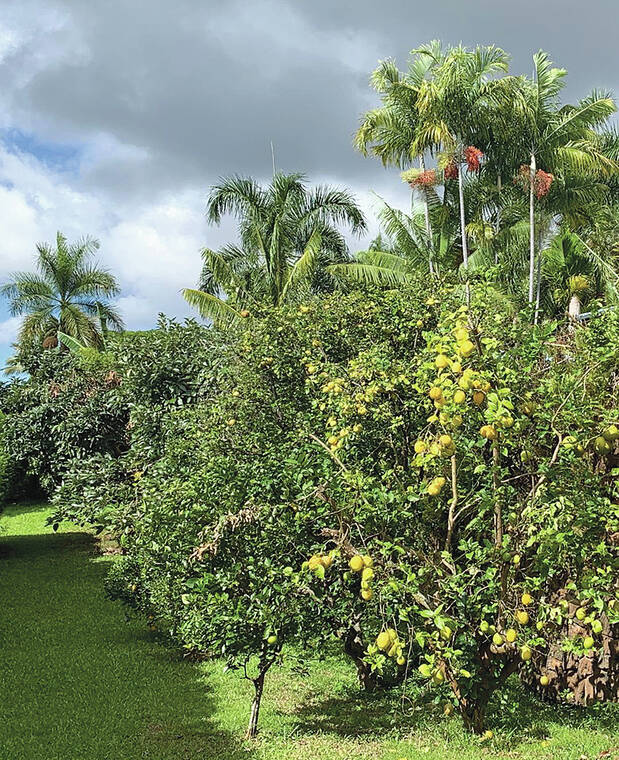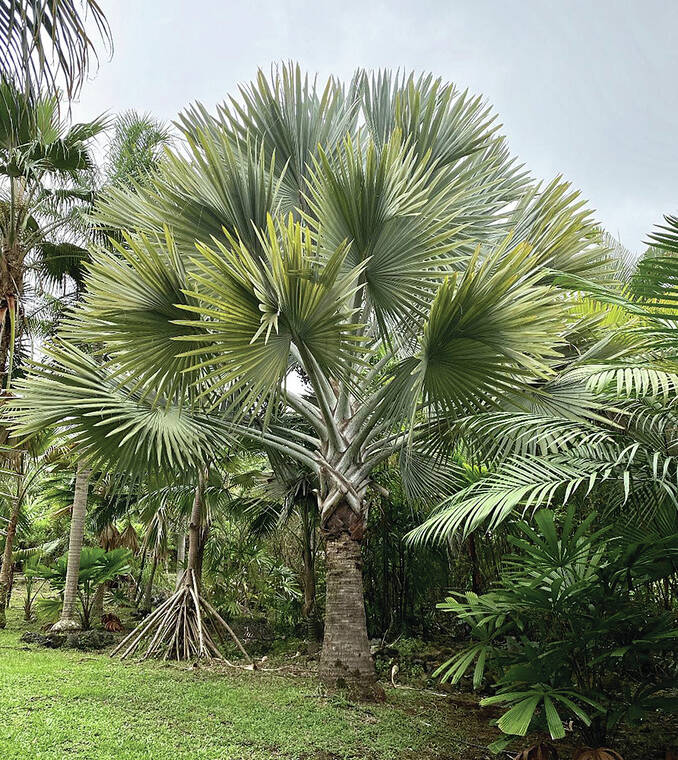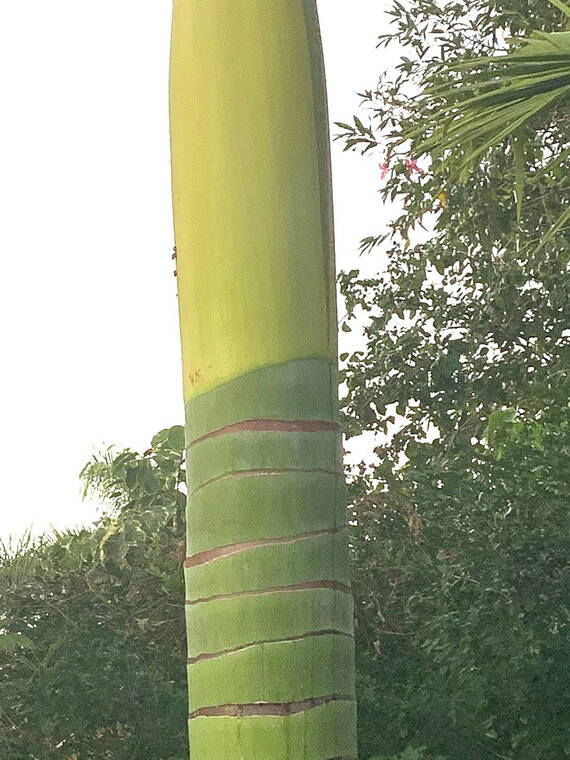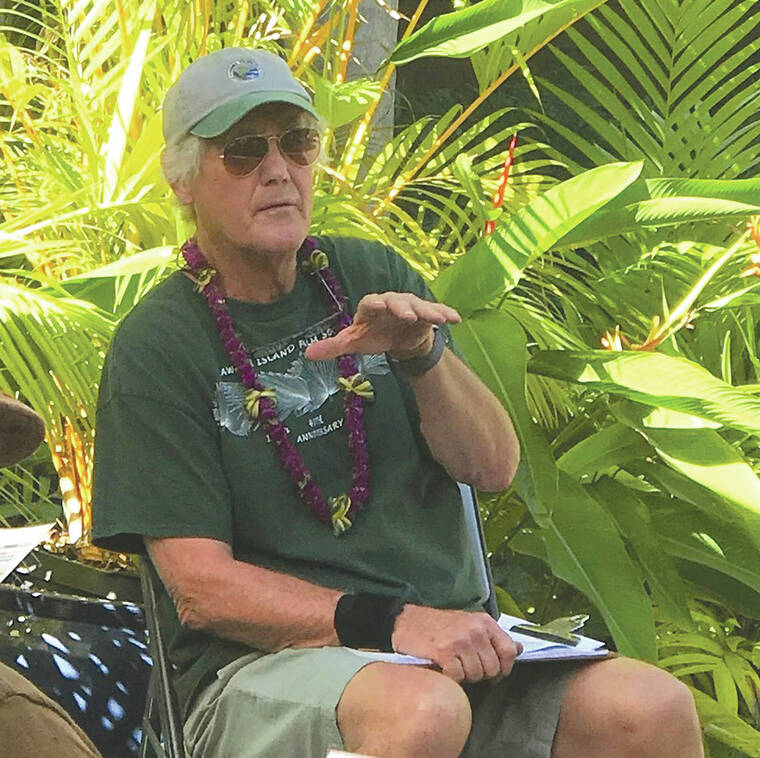To call Stosh Thompson a palm enthusiast would be an understatement. During our meeting, I realized that palms are his passion. He loves them, which is evidenced by his 1-acre palm garden filled with over 180 different palm species. He calls the collection his Palmarium.
Stosh is no stranger to collections. He grew up in Oregon where his mother collected rare plants. She went on to help found the National Tropical Botanical Garden on Kauai. He only wishes she could be alive today to see his palm collection.
The first time Stosh visited the tropics, he was 12 years old. He describes his feelings from that visit.
“The tropical aura of the coconut palms captivated me,” he reports.
Years later, in the ‘90s, he bought a condo in Kona. He noticed that six different kinds of palms were growing on the property. No one knew their names. That got Stosh started. He bought a palm book that described about 100 different varieties and proceeded to go around the island identifying palms.
Though he owned a 700-acre property in Oregon that he ranched and farmed, he decided to buy some land here in Kona. In 2006 he bought a 1-acre lot in Kalaoa and started installing palms. King palm, foxtail palm, bottle palm and a Manila palm were among his early acquisitions.
Stosh soon met other palm enthusiasts including Garrett Webb of Kalaoa Gardens and Jeff Marcus of Floribunda Palms and began buying new varieties from their nursery stock. He also joined the Hawaii Island Palm Society and attended some of their quarterly palm tours. These connections made it possible for him to learn more about palms and start acquiring some rare and interesting varieties.
He described the progression of palm aficionados like himself, “It starts with interest in palms that can be an affliction without explanation or treatment. True “palm nuts” might think that they have finished planting, until they see a new specimen, and that they must have. At this point the affliction has become an addiction.”
He found that “palm nuts” enjoy getting together to share their experiences and, of course, share their love of palms with each other.
Wanting to share his collection, Stosh decided to open his garden for tours. Lots of interested folks came for the tours until the pandemic shut it all down. As things started to open up a bit, he decided to reopen and offer free self-guided tours. Today, he offers guided as well self-guided ones by reservation. You can go to his website to reserve a time for a tour at thompsonpalmarium.com.
Touring the palm garden allows the visitor to see multiple mature palm varieties up close. Seeing them near one another, the distinct differences in shape, size and color become apparent. Their preferences also become clear based on their placement in the garden and the way they are being cultivated.
To keep the garden looking beautiful takes a bit of work. Stosh listed a few of the tasks required. Of course, proper siting of each new acquisition is paramount. He attempts in every case to replicate the palm’s original habitat. This means giving each palm the proper light, water and growing conditions needed for it to thrive. He did admit that he occasionally loses a palm when conditions in the garden change or when lethal pests arrive.
One of his worst enemies is the New Guinea sugarcane weevil. This insect, which began as a sugar cane pest, has now developed a taste for palms, especially the native Pritchardias. Its presence is identified by the holes it makes in a palm’s trunk. It is eventually deadly to the palm host. Mites, scale and whiteflies also threaten Stosh’s palms in addition to fungal diseases and mold.
Add to pest control, the usual gardener’s tasks of watering weeding and trimming. All are on Stosh’s list of chores. He finds that he can get most of the maintenance work done with a little help from his friend Beverly Phillips in ten to twenty hours a week. Twice a month, he hires maintenance help to do the mowing and haul a pickup truck or two of palm fronds and green waste off site.
When I asked him to name some of his favorite palms, Latin names started rolling off Stosh’s tongue. Among those are the Samoan native, Clinostigma samoense with a distinctive yellow-green crownshaft and irridescent green trunk with distinct rings. He also mentioned a Vanuatu native, Carpoxylon macrospermum, that he describes as having pure symmetry and dramatic color. The striking and massive Bismarkia nobilis also gets a high mark on his favorites list.
In his collection, Stosh has made sure to include native Pritchardia palms. He finds the natives have little resistance to the palm diseases that have arrived from other places. Since the diseases have found their way here, a few of his natives have succumbed to them. Of the five varieties native to the Big Island, he is only able to keep three growing in his garden.
Among his collection are some palms with edible parts and hearts. Coconut palms, peach palms, the acai palm and betelnut palms all produce edible fruit. The fruit of the jelly palm is high in pectin, hence the name. Palm sugar is derived from the fruit or sap of several different palms including the Borassus flabellifer, which Stosh has on site.
Many of these and others including his favorite Carpoxylon macrospermum have tasty hearts but that would mean killing the palm. This is not something Stosh would ever want to do. Occasionally he does have to remove a palm for maintenance concerns, however. On these few occasions, he has tasted the hearts of those he had to remove and pronounced them delicious.
If tending a Palmarium were not enough to do, Stosh has also planted about 30 fruit trees. These include several citrus and avocado varieties as well as starfruit, papayas, mangos, bananas and a few coffee trees.
All this is a lot of work, but Stosh is up to the task, inspired and driven by his love of palms. Make a point to contact him and schedule a visit to see Stosh’s Palm Garden for yourself. Though he is currently doing some remodeling, the garden will be open again in mid June. To get in touch and see a preview of what’s in store, check out his website at thompsonpalmarium.com.
Diana Duff is a plant adviser, educator and consultant living part time in Kailua-Kona.
Gardening events
Thursdays in April and May: “Talk Story with Coffee Berry Borer researchers” noon to 1 p.m. Presentation topics: IPM for CBB and Coffee Leaf Rust (CLR) monitoring. Open to all. Contact Roseann Leiner roseannl@hawaii.edu (808) 969-8256 for information or to request an auxiliary aid or service at least seven days before the event. Information and registration: https://www.eventbrite.com/e/talk-story-with-coffee-berry-borer-researchers-2022-tickets-288914339567.
Pesticide Subsidy Program Outreach to Coffee Farmers: To take advantage of the HDOA CBB and Coffee Leaf Rust (CLR) Pesticide Subsidy Program contact Melanie Bondera at (808) 323-7578 or email hdoa.cbb@hawaii.gov with questions.
Saturday, June 18: “Hawaii Coffee and Cacao Festival” at the Kaka’ako Farmer Market in Honolulu. The festival is seeking growers, producers, chocolatiers, baristas, chefs and related Coffee &Cacao items. Vendors: RSVP by May 1 by filling out an application and waiver at alohafarmlovers@gmail.com. w
Farmer direct markets
(check websites for the latest hours and online markets)
Wednesday: “Ho’oulu Farmers Market” at Outrigger Kona Resort &Spa at Keauhou Bay
Saturday: “Keauhou Farmers Market” 8 a.m. to noon at Keauhou Shopping Center
Information on their online market: keauhoufarmersmarket.com/onlinemarket
“Kamuela Farmer’s Market” 7:30 a.m. to noon at Pukalani Stables
“Waimea Town Market” 7:30 a.m. to noon at the Parker School in central Waimea
“Waimea Homestead Farmers Market” 7:30 a.m. to noon at the Waimea middle and elementary school playground
Sunday: “Pure Kona Green Market” 9 a.m. to 2 p.m. at Amy Greenwell Garden in Captain Cook
“Hamakua Harvest” 9 a.m. to 2 p.m. at Highway 19 and Mamane Street in Honoka’a
Plant Advice Lines
Anytime: konamg@ctahr.hawaii.edu; Tuesdays and Thursdays from 9 a.m. to noon at UH-CES in Kainaliu at (808) 322-4893. Walk-in from 9 a.m. to noon Mondays, Tuesdays, and Fridays at the UH-CES at Komohana in Hilo or call (808) 981-5199 or email himga@hawaii.edu





















